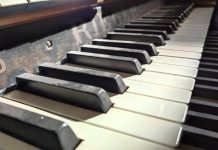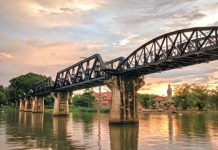U-Tapao, Thailand – U.S., Royal Thai, Malaysian and Japanese services practiced noncombatant evacuation operations during exercise Cobra Gold 16, at U-Tapao, Thailand, February 17, 2016.
Cobra Gold is a multi-national exercise designed to increase cooperation and interoperability through solving solutions for common challenges through training.
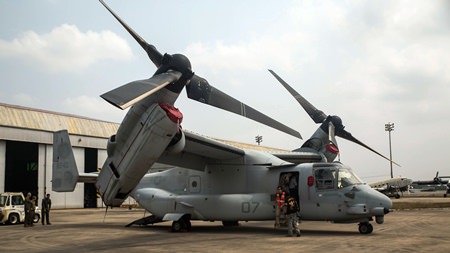 A MV-22 Osprey sits on display for Thai, Malaysian and Japanese service members and spectators to tour during a noncombatant evacuation demonstration as part of exercise Cobra Gold 16 at U-Tapao, February 17.
A MV-22 Osprey sits on display for Thai, Malaysian and Japanese service members and spectators to tour during a noncombatant evacuation demonstration as part of exercise Cobra Gold 16 at U-Tapao, February 17.
During the evacuation training event Marine Medium Tiltrotor Squadron 262 set up an MV-22 Osprey as a static display for the partner services while partner nations practiced actual evacuations.
“This is the civic action portion,” said 1st Lt. Danilo O. Rodriguez, the officer in charge of the evacuation control center with 31st Combat Logistics Battalion, 31st Marine Expeditionary Unit, III Marine Expeditionary Force. “There’s humanitarian assistance and disaster relief that goes into this entire Pacific region. We can’t ignore that by focusing only on kinetic action. In this case, it allows us to be prepared for the next typhoon that hits the Philippines or the next disaster that hits Nepal.”
Rodriquez is part of a team that is designed to mitigate casualties during these types of disasters.
“We have the ability to liaison with the embassy representative in the nation we are deployed to,” said Rodriquez, from San Diego, California. “We have the ability to extract upward of 300 or more citizens.”
For Cobra Gold Rodriguez and his team are working with Marine VMM 262, Marine Aircraft Group 36, 1st Marine Aircraft Wing, III MEF, which was deployed for immediate aid in Nepal after the earthquakes struck in May, 2015.
“The Osprey gives those coordinating at the embassy, MEU, and MEB levels different options they wouldn’t normally have with just a helicopter or C-130,” said Lt. Col. Matthew A. Baldwin, the commanding officer with VMM 262 from Bellevue, Washington.
Traditional helicopters can be very weight and range limited during supply and evacuation focused missions. The Osprey has the ability to travel farther with a bigger capacity for supplies or personnel.
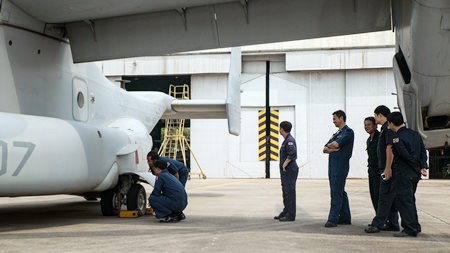 A group of Royal Thai service members inspect a MV-22 Osprey during a noncombatant evacuation demonstration as part of exercise Cobra Gold 16.
A group of Royal Thai service members inspect a MV-22 Osprey during a noncombatant evacuation demonstration as part of exercise Cobra Gold 16.
“The Osprey is a very popular aircraft,” said Rodriquez, from San Diego, California. “Other nations are always curious about it, which is one of the reasons we wanted to have it out here. [The other services] can actually board it and have a tour of the capabilities it offers.”
During the practice, Malaysia, Thailand and Japan demonstrated their own capabilities by using fixed wing and traditional helicopters.
“I believe all of us being here have taken away from each nation as far as how they execute their own portion of the ECC,” said Rodriguez. “My Marines came here well prepared for this type of exercise, but being able to work with other nations is a new and great experience. I know they’ll be more prepared in a bilateral type of environment in the future.”
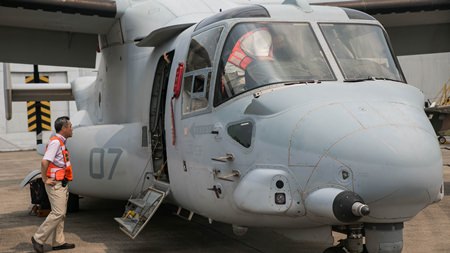 Japanese observers tour and examine a MV-22 Osprey during a noncombatant evacuation demonstration as part of exercise Cobra Gold 16 at U-Tapao. (U.S. Marine Corps photo by Cpl. William Hester/ Released)
Japanese observers tour and examine a MV-22 Osprey during a noncombatant evacuation demonstration as part of exercise Cobra Gold 16 at U-Tapao. (U.S. Marine Corps photo by Cpl. William Hester/ Released)


